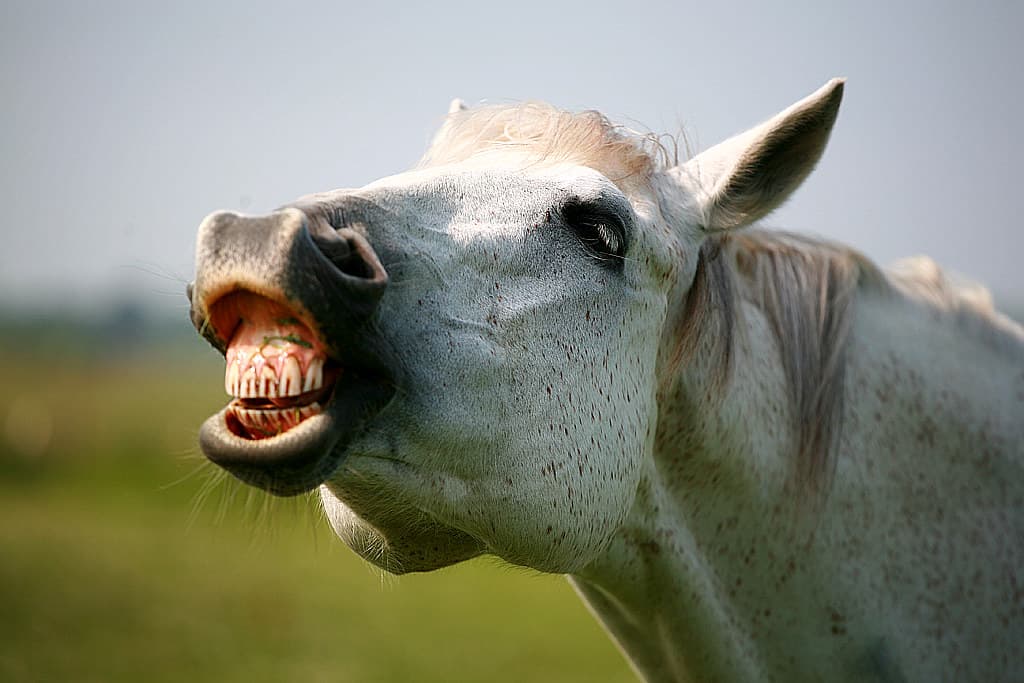The Flehmen response, a unique behavioral display across various mammalian species, involves the curling back of the upper lip to expose the front teeth and gums, followed by inhalation and a temporary pause in this posture. This act is commonly observed in ungulates and felines and is primarily associated with the detection and analysis of pheromones and other significant scents through the vomeronasal organ (VNO), positioned above the mouth’s roof.
Origins and Discovery
Coined from the German term “flehmen,” meaning to bare the upper teeth, and influenced by Upper Saxon German “flemmen,” signifying a spiteful look, the term was popularized in the early 20th century. The behavior itself, however, was first noted by Frederik Ruysch and later detailed by Ludwig Jacobson in the early 19th century, shedding light on the anatomical and functional aspects of the VNO in scent processing.
Behavioral Description
Characterized by the exhibition of what appears to be a grimace, the Flehmen response is a complex behavior involving the exposure of teeth and gums, nostril closure, and scent inhalation. This behavior can be observed when animals encounter specific scents or substances, often resulting in them stretching their necks and elevating their heads to enhance scent detection.
Biological Mechanism
This response facilitates the entry of air, carrying pheromones and other scents, into the vomeronasal organ, a secondary olfactory system crucial for detecting non-volatile organic compounds. Unlike humans, animals that demonstrate the Flehmen response possess a direct anatomical pathway allowing for the transfer of these scents from the mouth to the VNO.
Chemical Communication
The primary role of the Flehmen response is to analyze chemical cues, specifically non-volatile organic compounds, which do not readily evaporate. These compounds, including pheromones and hormones, are essential for intra- and interspecies communication, contributing to various behavioral and reproductive processes.
Functions and Implications
Beyond its role in scent investigation, the Flehmen response is integral to social and reproductive behaviors, aiding in the identification of mating readiness, facilitating reproductive synchronization, and even influencing post-birth interactions among species. Its occurrence varies across life stages, with notable differences in frequency and context observed between juveniles and adults, as well as between genders.
Observations Across Mammalian Species
While commonly associated with domesticated animals like cats and horses, the Flehmen response is exhibited by a wide array of mammals, from ungulates to felids, each adapting this behavior to their environmental and social contexts. This broad occurrence underscores the evolutionary significance of the VNO and chemical communication in mammalian species.
Evolutionary Significance
The Flehmen response, beyond its immediate functional roles in communication and reproduction, offers profound insights into the evolutionary trajectory of mammalian sensory capabilities. This behavior underscores the pivotal role of the vomeronasal organ in the survival and reproductive success of numerous species, highlighting an evolutionary advantage conferred by sophisticated chemical communication mechanisms. The existence of the Flehmen response across a diverse range of mammals, from ungulates to felids, suggests a common ancestral trait that has been preserved and adapted to suit the ecological niches and social structures of different species.
Understanding the evolutionary underpinnings of the Flehmen response illuminates the complex interplay between sensory perception, environmental adaptation, and social interaction in the animal kingdom. It reveals how evolutionary pressures have shaped the development of specialized organs and behaviors to optimize reproductive success and survival. The study of this response, therefore, contributes to a broader comprehension of mammalian evolution, providing a window into the intricate mechanisms through which animals perceive and interact with their world.
Sociocultural Impact
The Flehmen response, while a natural and common behavior among many mammals, also holds a fascinating place in human perception of animal behavior. Often interpreted as humorous or mischievous due to its distinctive grimace-like appearance, the Flehmen response has captivated the curiosity and imagination of people, influencing cultural representations of animals in art, literature, and media. This anthropomorphic interpretation of animal behavior reflects the human tendency to ascribe human emotions and intentions to non-human entities, shaping our relationships with and attitudes towards the animal world.
The portrayal of the Flehmen response in societal and cultural contexts can serve as a lens through which to explore the human-animal bond, highlighting the importance of understanding animal behaviors within their ecological and biological frameworks. By demystifying such behaviors, we can foster a deeper appreciation for the complexity of animal life, encouraging conservation efforts and promoting empathy towards animals. The Flehmen response thus represents not only a critical aspect of animal communication but also a point of connection between humans and the natural world.
Key Takeaways
- The Flehmen response is a crucial behavior for chemical communication among mammals;
- It involves the exposure of the upper teeth and inhalation of scents to the vomeronasal organ;
- This response is observed across various mammalian species, indicating its evolutionary significance;
- Understanding the Flehmen response enriches our knowledge of animal behavior and interspecies communication;
- It also influences human perceptions of animals, contributing to cultural and societal views on wildlife.
Conclusion
In studying the Flehmen response, we uncover a fascinating story that links evolutionary biology, animal behavior, and the complex ways animals communicate without words. This behavior is a key example of how sophisticated nature’s communication methods are, and it helps us understand how animals interact with each other and their surroundings. The Flehmen response gives us valuable insights into animal perception, social interactions, and reproductive strategies. This research goes beyond just academic interest. It shows us how evolutionary adaptations have allowed mammals to survive and thrive in various environments by highlighting the importance of chemical communication. This type of communication is crucial for everything from basic social interactions to complex mating behaviors. The Flehmen response shows how interconnected life is, and it reveals the common links between humans and the rest of the natural world.
Reflecting on this behavior emphasizes the need for a deeper and more empathetic understanding of animals. By recognizing the sophisticated ways animals engage with their environment, we’re encouraged to think about our role in nature. This promotes conservation and a more sustainable way of living alongside the diverse life forms on our planet. Studying the Flehmen response isn’t just about animal behavior; it’s a reminder to appreciate and respect the complexity and beauty of nature’s designs.



